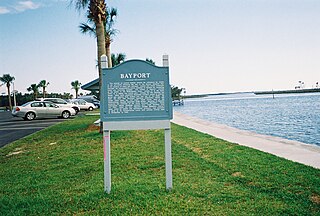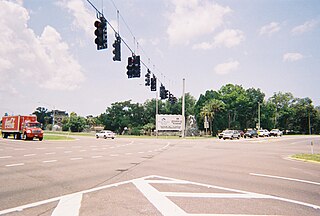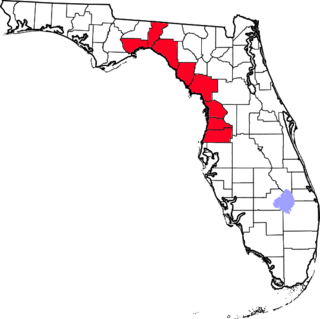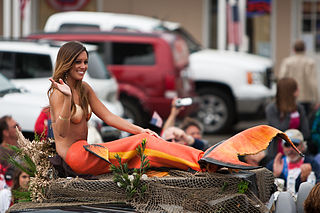
Bayport is an unincorporated community and census-designated place (CDP) in Hernando County, Florida, United States. The population was 43 at the 2010 census.

Spring Hill is a census-designated place (CDP) in Hernando County, Florida, United States. The population was 113,568 at the 2020 census, up from 98,621 at the 2010 census. Spring Hill belongs to Florida's Nature Coast region and is in the Tampa-St. Petersburg-Clearwater metro area. It is east of Hernando Beach, southwest of Brooksville, and north of Tampa.

Weeki Wachee is an unincorporated community and former city located in Hernando County, Florida, United States. As of the 2020 census, the community has a total population of 16. The 12,000-acre (4,900 ha) Weeki Wachee Preserve and the Weeki Wachee Springs park are located in the area. The park includes water rides, animal shows, mermaid costume shows, and manatee watching. The communities of Weeki Wachee Gardens and Spring Hill are nearby.

The Nature Coast is an informal, unofficial region of the U.S. state of Florida. The broadest definition of the Nature Coast includes the eight counties that abut the Gulf of Mexico along the Big Bend Coast defined by geologists: from west to east, Wakulla, Jefferson, Taylor, Dixie, Levy, Citrus, Hernando, and Pasco counties. The name "Nature Coast" was originally devised as part of a marketing campaign to promote tourism in Levy, Citrus, Hernando, and parts of Marion and Pasco counties.

Rainbow Springs, formerly known as Blue Spring, is a first-magnitude artesian spring formation in Marion County, Florida, United States, several miles north of the city of Dunnellon. Rainbow Springs is the focal point of Rainbow Springs State Park. The spring formation is the fourth-largest in Florida, and produces over 490 million gallons of water daily. Rainbow Springs forms the headwaters of the Rainbow River, which empties into the Withlacoochee River.

Rainbow Springs State Park is a Florida state park located on U.S. 41, 3 miles (5 km) north of Dunnellon, Florida. It comprises 1,459.07 acres (5.9046 km2) upland and 12.83 acres (51,900 m2) submerged. The most significant natural feature is the first-magnitude headspring basin, which produces up to 600,000,000 US gallons (2,300,000 m3) of fresh water per day, forming the Rainbow River. The looking-glass waters of Rainbow Springs come from several vents, not one large bubbling spring. The river itself supports a wide variety of fish, wildlife, and plants, many within easy viewing by visitors. In total, the park contains 11 distinct natural communities, including sandhills, flatwoods, upland mixed forests, and hydric hammocks.

Wakulla Springs is located 14 miles (23 km) south of Tallahassee, Florida and 5 miles (8.0 km) east of Crawfordville in Wakulla County, Florida at the crossroads of State Road 61 and State Road 267. It is protected in the Edward Ball Wakulla Springs State Park.

The Big Bend of Florida, United States, is an informally-named geographic region of North Florida where the Florida Panhandle transitions to the Florida Peninsula south and east of Tallahassee. The region is known for its vast woodlands and marshlands and its low population density relative to much of the state. The area is home to the largest single spring in the United States, the Alapaha Rise, and the longest surveyed underwater cave in the United States, the 32-mile (51 km) Wakulla-Leon Sinks cave system.

The Weeki Wachee River is a river in Hernando County, Florida, United States. It flows 12 miles (19 km) westwards from Weeki Wachee to the Gulf of Mexico at the Weeki Wachee estuary. The name is derived from the Seminole: uekiwv /oykéywa, wi:-/ "spring" and -uce /-oci/ "small", signifying either a small spring or an offshoot of a town named Spring. The river is best known for its spring, and the Weeki Wachee Springs attraction built on the premises. The spring is the surfacing point of an underground river, which is the deepest naturally occurring spring in the United States. It measures about 150 feet (46 m) wide and 250 feet (76 m) long, and daily water averages 150 million gallons. The water temperature is a steady 72–74 °F (22–23 °C) year-round.

Newton A. Perry was an American swimmer, attraction promoter, educator and swimming coach.

Mermaids, like many other creatures of mythology and folklore, are regularly depicted in literature, film, music, and popular culture. In the folklore of some modern cultures, the concept of the siren has been assimilated to that of the mermaid. For example, the French word for mermaid is sirène, Italian sirena, and similarly in certain other European languages. This usage existed by the Middle Ages.

Mr. Peabody and the Mermaid is a 1948 American romantic fantasy film directed by Irving Pichel starring William Powell and Ann Blyth in the title roles. The film was based on the 1945 novel Peabody's Mermaid by Guy and Constance Jones. Sequences were shot at the Weeki Wachee Springs in Florida; Blyth's swimming doubles were Nancy Tribble and Mary Ann Ziegler.

Karst Underwater Research (KUR) is a registered 501(c)(3) non-profit organization that specializes in the research and documentation of karst aquifers and their corresponding surface features. KUR members perform a variety of scientific processes, including mapping and cartography, radio location, photography, videography, YSI water analysis and sampling.
Buccaneer Bay is a name for many water and amusement parks, such as:

Michael Dweck is an American visual artist and filmmaker. Best known for his narrative photography, Dweck's work "explores ongoing struggles between identity and adaptation in endangered societal enclaves." In 2003, he became the first living photographer to have a solo exhibition at Sotheby's, and in 2012, he was the first American photographer to exhibit his work in Cuba since the beginning of the United States embargo in 1960. He lives and works in New York City and in Montauk, New York.

Mermaiding is the practice of wearing, and often swimming in, a costume mermaid tail.

Ginger Stanley was an American model, actress and stunt woman.
Eric Jonathan Ducharme, also known as "The Mertailor", is an American mermaid aficionado, or "merman", artist, and businessman. Ducharme makes and sells mermaid related costume apparel. He has performed in and modeled his products.

Cave diving is underwater diving in water-filled caves. The equipment used varies depending on the circumstances, and ranges from breath hold to surface supplied, but almost all cave diving is done using scuba equipment, often in specialised configurations with redundancies such as sidemount or backmounted twinset. Recreational cave diving is generally considered to be a type of technical diving due to the lack of a free surface during large parts of the dive, and often involves planned decompression stops. A distinction is made by recreational diver training agencies between cave diving and cavern diving, where cavern diving is deemed to be diving in those parts of a cave where the exit to open water can be seen by natural light. An arbitrary distance limit to the open water surface may also be specified. Despite the risks, water-filled caves attract scuba divers, cavers, and speleologists due to their often unexplored nature, and present divers with a technical diving challenge.
MerPeople is a documentary miniseries that premiered May 23, 2023, on Netflix. It explores the subculture and performing art of "mermaiding."























